#queen maria ii of portugal
Text
Tiaras at Ajuda Palace
Last summer the new Royal Treasury Museum within Ajuda National Palace in Lisbon was opened to display the Portuguese Crown Jewels. The new museum was built using insurance money from the 2002 theft of some of the jewels when they were on exhibition in the Netherlands and was part of a larger restoration project of the palace. Find out more about visiting here.
youtube
The museum features several tiaras and a lot of other jewelry like the emerald bow brooch below that I just had to include.
Queen Maria Pia's Diadem of Stars by Estêvão de Sousa, 1868 with later alterations
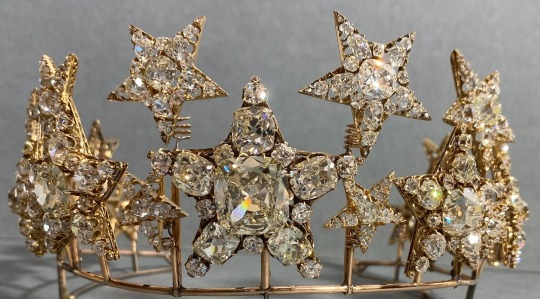
Queen Maria Pia's Laurel Wreath Tiara by Castellani, circa 1862 as a wedding gift from the city of Rome

Queen Maria Pia's Coral Tiara, circa 1862 as a wedding gift from the city of Naples

Queen Maria II's Sapphire Tiara, 1840s - This tiara is not part of the crown jewels and was sold at Christie's in 2021 for 1,948,558 USD but the new owner has loaned it to the museum.

Infanta Maria Ana's Emerald Bow Brooch, mid 1700s with later tassel addition

#tiara exhibition#Portuguese Royal Family#Queen Maria Pia#Queen Maria II#Queen Maria#Portugal#Castellani#coral#emerald#brooch#star tiara
96 notes
·
View notes
Photo

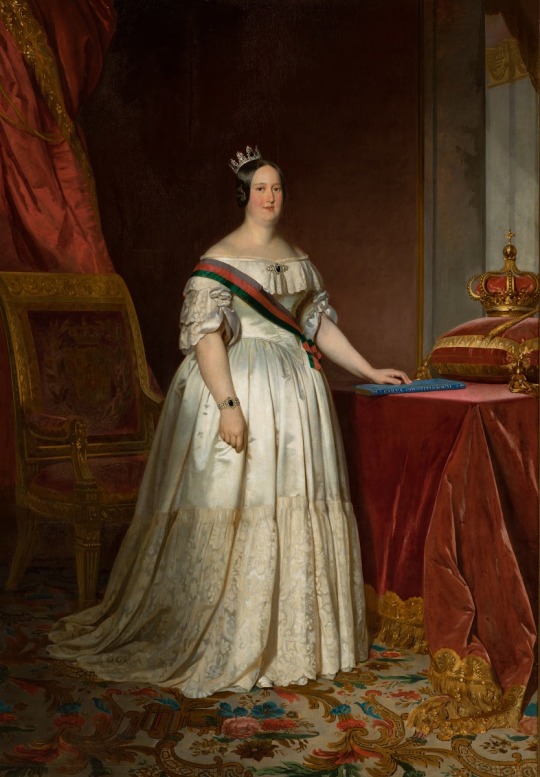




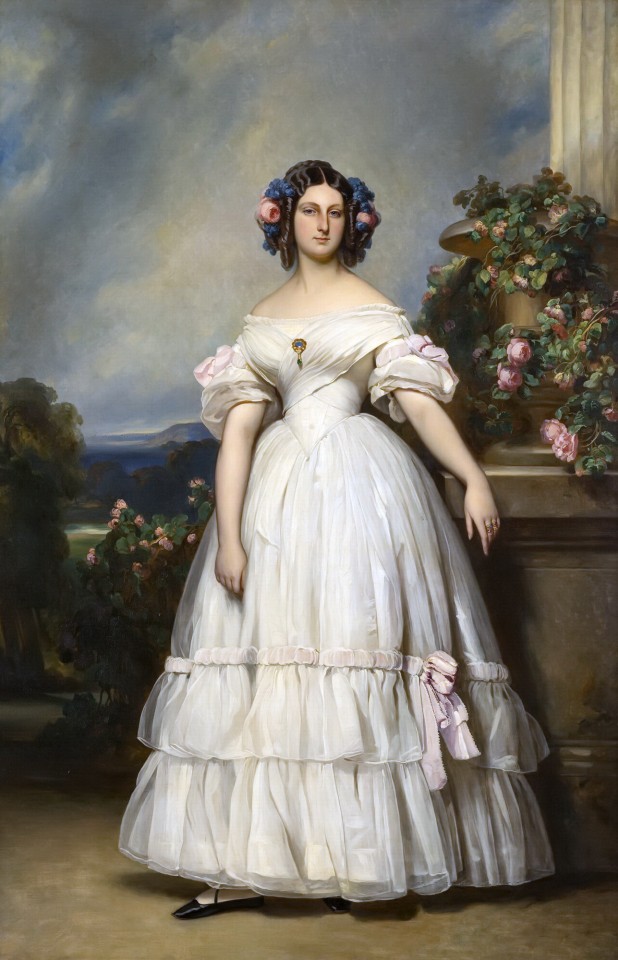



1846 fashion in pictures -
Top: 1846 Queen Victoria at the Age of 27 Years by ? (was for sale by Boris Wilnitsky). Image cropped to remove shadowed areas along the left, top, and right edges. Print, spots, & flaws removed w Pshop 1143X1953 @72 584kj.
Second row left: 1846 Rainha D. Maria II by Ferdinand Krumholz (Palácio da Ajuda - Ajuda parish, Lisboa, Portugal). From Wikimedia 834X1200 @72 325kj.
Second row right: 1846 Maria Nikolaievna by Carl Timoleon von Neff (location ?). From liveinternet.ru/users/lara_rimmer/post458270808/ 1000X1342 @96 369kj.
Third right: 1846 Prinses Marianne van Oranje-Nassau by Jan Philip Koelman (Geschiedkundige Vereniging Oranje-Nassau/Historical Society of Orange-Nassau, Paleis Het Loo - Den Haag, Zuid Holland, Netherlands). From Wikimedia 1508X2000 @96 498kj.
Fourth row left: 1846 Adriana Wilhelmina Clara Hooft by Jan Baptist van der Hulst (Frans Hals Museum - Haarlem, Noord-Holland, Netherlands). From history-of-fashion.tumblr.com/image/136328711994 900X1186 @72 474kj.
Fourth row right: 1846 Lady Fitzharris by Richard James Lane after Edwin Landseer (British Museum). From their Web site 1927X2500 @300 1.1Mj.
Fifth row: 1846 Princess Clementine of Orleans, Princess of Saxe-Coburg-Gotha by Franz Xaver Winterhalter (Châteaux de Versailles et de Trianon - Versailles, Île-de- France, France). From gallerix.ru/storeroom/1941543836/N/2028134133/ 1287X1998 @72 607kj.
Sixth row left: 1846 Augustine-Modeste-Hortense Reiset by Jean Auguste Dominique Ingres (Fogg Museum, Harvard University - Cambridge, Massachusetts, USA). From Wikimedia 1855X2295 @95.19 912kj.
Sixth row right: 1846 María Francisca de la Gándara, Dowager Countess of Calderón by Vicente López y Portaña (Prado). From their Web site ©Museo Nacional del Prado 1475X1920 @96 876kj.
Seventh row: 1846 Augusta Großherzogin von Mecklenburg-Strelitz (1822-1916, née Princess of Cambridge) by Franz Xaver Winterhalter (Royal Collevtion). From Wikimedia 2480X2933 @150 1.1Mj.
#1846 fashion#early Victorian fashion#Biedermeier fashion#Louis-Philippe fashion#Queen Victoria#poke bonnet#Maria II of Portugal#Ferdinand Krumholz#V waistline#Maria Nikolaievna#Carl Timoleon von Neff#lace head scarf#Marianne of the Netherlands#Jan Philip Koelman#high neckline#Adriana Wilhelmina Clara Hooft#Jan Baptist van der Hulst#pleated bertha#Lady Fitzharris#Richard James Lane#Edwin Landseer#Clementine of Orleans#Franz Xaver Winterhalter#Clementine d'Orléans#Augustine-Modeste-Hortense Reiset.#Jean Auguste Dominique Ingres#María Francisca de la Gándara#Vicente López y Portaña#Augusta von Mecklenburg-Strelitz
132 notes
·
View notes
Text
youtube
𝓣𝓱𝓮 𝓯𝓸𝓾𝓻 𝔀𝓲𝓿𝓮𝓼 𝓸𝓯 𝓟𝓱𝓲𝓵𝓲𝓹 𝓘𝓘
#the four wives of philip ii#philip ii#philip ii of spain#felipe ii#felipe ii de españa#maría manuela of portugal#mary tudor#elisabeth of valois#anna of austria#mary i of england#maria manuela de portugal#isabel de valois#las cuatro esposas de felipe ii#carlos rey emperador#el ministerio del tiempo#queens: the virgin and the martyr#la conjura del escorial#reinas:virgen y martir#maría tudor#ana de austria#Isabel clara eugenia#catalina micaela#period drama#period drama edit#Youtube
4 notes
·
View notes
Text









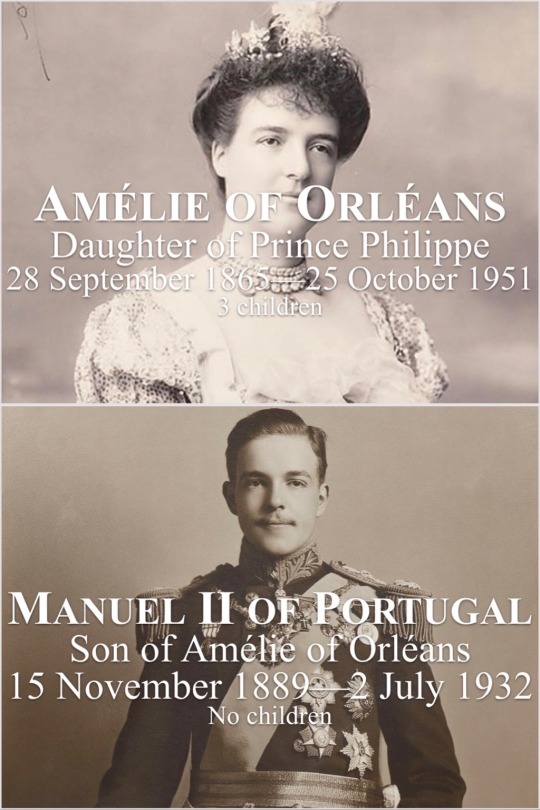
Descendants of the Tudors
#descendants of the tudors#henry vii#margaret tudor#james v#mary queen of scots#james vi and i#elizabeth stuart#charles i louis#elizabeth charlotte madame palatine#philippe ii duke of orléans#charlotte aglaé d’orléans#maria teresa felicitas d’este#louise marie adélaïde de bourbon#louis philippe i#ferdinand philippe duke of orléans#prince philippe#amélie oforléans#manuel ii of portugal
2 notes
·
View notes
Photo

Did You Know: The House of Bragança Edition #4
The husbands of D. Maria II of Portugal and Queen Victoria were cousins! And it looks like that wasn’t the only thing that D. Fernando and Prince Albert had in common. ¬‿¬
“In many ways the two cousins were very similar, from their tall and handsome physique and their undoubted prowess in the marriage bed to their meticulous care over the education of their children and their active patronage of the arts and sciences.” (p. 252, The Braganzas: The Rise and Fall of the Ruling Dynasties of Portugal and Brazil, 1640–1910, Malyn Newitt)
#oh I'm certainly going to hell for this one :')#if this actually makes it onto your feed#know that I lost my mind#Did You Know: The House of Bragança#Portuguese history#Portugal#no but in reality Maria II and Queen Victoria were very good friends#they had known each other since they were young girls#they often exchanged letters#and kept photos of each other#D. Maria sent Victoria a bracelet with the portrait of her firstborn Pedro#and Queen Victoria kept Maria's portrait in her closet#soulmate vibes#I'm just saying#maria ii of portugal#queen victoria#my entries
15 notes
·
View notes
Text

Queen Maria II da Gloria. By Joannes Paulus.
#reino de portugal#casa de bragança#kingdom of portugal#house of braganza#full length portrait#maria ii da gloria#rainha de portugal#queen of portugal#joannes paulus#full-length portrait#maria ii de portugal
5 notes
·
View notes
Text
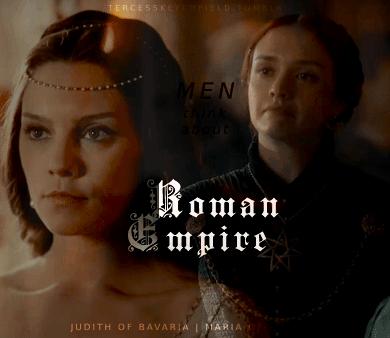
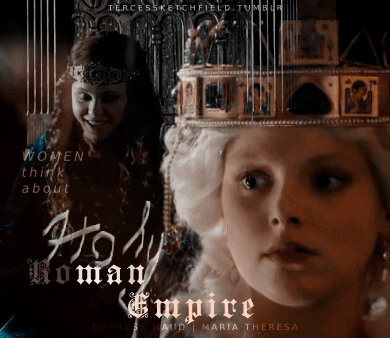
MEN THINK ABOUT ROMAN EMPIRE. WOMEN THINK ABOUT HOLY ROMAN EMPIRE
JUDITH OF BAVARIA (797-843) — Daughter of Count Welf I of Bavaria, Judith was a Carolingian Empress as the second wife of Louis I the Pious. Mother of Gisela and Charles the Bald, she foght for both her own influence at court and for the succession of her son over the claims of his elder half-brothers, the sons of Louis I from his first marriage. Charles became the Emperor in 875, after the death of Louis II, his nephew and a son of his half-brother Lothair / fancast: Annabel Scholey
MARIA OF AUSTRIA (1528-1603) — Daughter of Charles V, Holy Roman Emperor, and Isabella of Portugal. She served as Regent of Spain both jointly with her husband, Maximilian (before their accession to the imperial throne), and in person, for her father, and brother, Philip II. Her children include two Holy Roman Emperors, Rudolf II and Matthias, over whom she held great influence, and queens consorts of Spain, and France / fancast: Olivia Cooke
EMPRESS MAUD (1102-1167) — Daughter of Henry I of England and Matilda of Scotland. Her first marriage to the Holy Roman Emperor, Henry V, gave her the title under which she came down into history, and was a source of great pride to Maud. Rightful heiress of Henry I, she confronted her cousin, King Stephen, in the civil war, known as the Anarchy, fighting ferociously for her rights. She failed in this for herself but won for her son Henry, who became king and established the Plantagenet dynasty in England / cast: Alison Pill in The Pillars of the Earth (2010)
MARIA THERESA (1717-1780) — She succeded her father Charles VI as the ruler of Habsburg monarchy in 1740, and devoutedly defended it against its enemies in the War of Austrian Succession and the Seven Year's War. Wife of the Holy Roman Emperor, Francis I, she was a forceful personality and a competent ruler herself, reigning first in her own right, and later, jointly with her son Empreror Joseph II. Her children include two Holy Romam Emperors (Joseph II and Leopold II), queens consorts of Naples ans Sicily, and France / cast: Marie-Luise Stockinger in Maria Theresia (2017)
#historyedit#judith of bavaria#maria of austria#empress maud#empress matilda#maria theresa#maria theresia#perioddramaedit#history#women in history#perioddramasource#onlyperioddramas#tusereliza#userbennet#usermina#weloveperioddrama#cortegiania#perioddramagif#gifshistorical#my edit#*i have literally zero idea what is this lmao* but i really like it idk
113 notes
·
View notes
Text

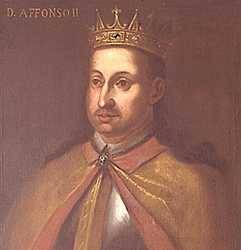
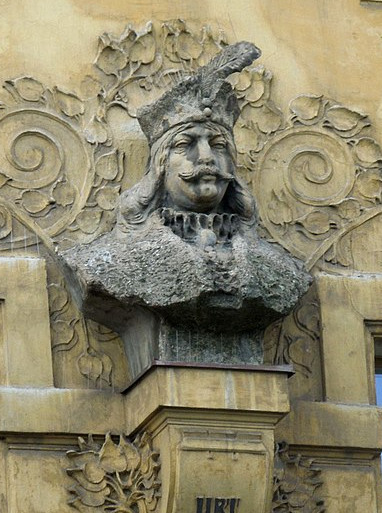

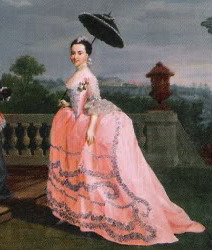





Royal Birthdays for today, April 23rd:
Malcolm IV, King of Scotland, 1141
Afonso II, King of Portugal, 1185
George of Poděbrady, King of Bohemia, 1420
Joan of France, Queen of France, 1464
Charlotte Amalie of Holstein-Plön, Duchess of Schleswig-Holstein-Sonderburg-Augustenburg, 1744
Aisha bint Al Hussein, Princess of Jordan, 1968
Zein bint Al Hussein, Princess of Jordan, 1968
Gabriella Kingston, Daughter of Prince Michael of Kent, 1981
Laetitia Maria of Belgium, Archduchess of Austria-Este, 2003
Louis of Wales, British Prince, 2018
#prince louis#Laetitia Maria of Belgium#Gabriella Kingston#Zein bint Al Hussein#Aisha bint Al Hussein#Charlotte Amalie of Holstein-Plön#joan of france#George of Poděbrady#afonso ii#malcolm iv#long live the queue#royal birthdays
17 notes
·
View notes
Text
Fun fact when Fernando of Saxe Coburgo Gotha arrived in Portugal to marry queen Maria II he did not have a beard and for that reason he was called Zé Nabo or Zé the Turnip
23 notes
·
View notes
Text

The Ducal Wittelsbach family and their relatives, early 1890s. From left to right, standing: Karl Theodor, Duke in Bavaria, Duchess Elisabeth in Bavaria, Archduchess Elisabeth Amalie of Austria, Duchess Sophie Adelheid in Bavaria, Archduchess Maria Annunziata of Austria, Princess Maria Immacolata of Bourbon-Two Sicilies, Duchess Marie Gabrielle in Bavaria.
Sitting: Archduchess Maria Teresa of Austria (née Infanta of Portugal), King Francesco II of the Two Sicilies, Queen Marie Sophie of the Two Sicilies (née Duchess in Bavaria)
Via As Infantas de Bragança e a Sua Descendência - História das Filhas de D. Miguel by Dativo Salvia Ocaña
#look what i found completely by chance! the quality isn't very good because it's from the book's preview#francesco died in december of 1894 so the picture is from before that date#but definetly 1890s because. puff sleeves#(also the author misidentifies maria teresa as her sister maria josé and maria annunziata as mathilde countess of trani)#karl theodor duke in bavaria#queen elisabeth of the belgians#elisabeth amalie of austria princess of liechtenstein#sophie in bavaria countess of toerring jettenbach#archduchess maria annunziata of austria#maria immacolata of bourbon-two sicilies princess of saxony#marie gabrielle in bavaria princess of bavaria#maria teresa of braganza archduchess of austria#francesco ii of the two sicilies#queen marie sophie of the two sicilies#house of wittelsbach#house of bourbon two sicilies#house of braganza
7 notes
·
View notes
Photo

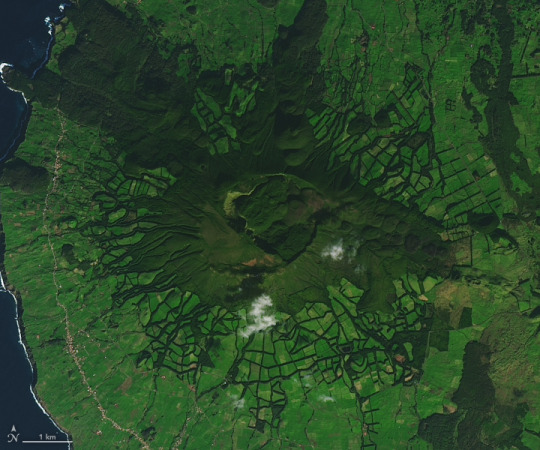
Terceira Island is one of nine volcanic islands in the Azores archipelago. The island straddles the Mid-Atlantic Ridge at a triple junction, an uncommon type of plate boundary where three divergent ridges meet.
Lying in the middle of the Atlantic Ocean about 1,400 kilometers (870 miles) off Portugal’s coast, the Azores archipelago is an autonomous region comprised of nine islands and home to almost a quarter million people. The islands are clustered in three groups in a chain spanning 600 kilometers (370 miles) across the Mid-Ocean Ridge. The westernmost island group lies on the North American tectonic plate, while the central and eastern groups lie on the Eurasian plate.
The islands of the Azores began to form about 10 million years ago over a mantle hotspot, similar to the formation of the Hawaiian Islands. However, unlike Hawai'i, which lies in the middle of a tectonic plate, the Azores lie on the edge.
The North American, Eurasian, and African plates meet to form the Azores triple junction— an uncommon type of plate boundary where three divergent ridges meet. (Most triple junctions involve a subduction zone where plates converge.) The North American and Eurasian plates are moving apart at a rate of 2 to 5 centimeters (0.75 to 2 inches) per year, an average speed for a spreading center. The Eurasian and African plates, however, are diverging at a hyperslow rate of 2 to 4 millimeters (0.08 to 0.16 inches) per year along the 550-kilometer (340-mile) Terceira Rift.
The rift passes through the island of Terceira, shown in the above image, which was acquired on January 3, 2020, by the Operational Land Imager (OLI) on Landsat 8. This 400-square-kilometer island in the central Azores first formed about 400,000 years ago. At the western end, Serra de Santa Bárbara rises to the island’s highest point at 1,021 meters (3,350 feet) above sea level.
Nearly a quarter of the island, which is dominated by forests and grasslands, has been designated as protected nature reserves. These include Biscoito da Ferraria Natural Forest Reserve in the north and Serra de Santa Bárbara in the west.

This detailed view shows the volcanic features of Serra de Santa Bárbara. The peak includes a double caldera, which formed from summit collapses 25,000 and 15,000 years ago. Also visible are small lava domes that formed on the eastern flank in 1761 during the last volcanic eruption to occur on land on Terceira.
The flanks of the volcano are covered by agricultural fields and pastures. The Azores are famous for the production of wine and tea, as well as cattle, which were brought by settlers in the 15th century. When the armadas of the Iberian empires ruled the seas, the Azores were a port of respite and resupply for ships in the mid-Atlantic. This was made possible by a deep-water anchorage at Angra do Heroísmo (“Bay of Heroism”). The harbor is sheltered by Monte Brasil, an extinct, 200-meter-tall volcanic cone attached to the south shore of the island. The second-largest town is Praia da Vitória (“Beach of Victory”). Both towns were named by Queen Maria II in the early 1830s to commemorate victories in the Portuguese civil war.
The island’s most recent volcanic activity occurred underwater on the Serreta Volcanic Ridge, which lies about 10 kilometers (6 miles) west of the island. That eruption started in December 1998 and continued through March 2000. During this eruption, a submarine plume emitted basalt balloons. These hot blobs of basaltic lava contain volcanic gases that expand, causing the lava balls to inflate and float to the surface. Once the gas dissipates and the lava is quenched by seawater, the newly formed igneous rocks sink back to the seafloor.
NASA Earth Observatory images by Lauren Dauphin, using Landsat data from the U.S. Geological Survey. Story by Sara E. Pratt.
188 notes
·
View notes
Text
youtube
ᴛʜᴇ ꜰᴏᴜʀ ᴡɪᴠᴇꜱ ᴏꜰ ᴘʜɪʟɪᴘ ɪɪ ᴏꜰ ꜱᴘᴀɪɴ - ᴅʏɴᴀꜱᴛʏ
#philip ii of spain#mary tudor#mary i#maria manuela of portugal#mary i of england#elisabeth of valois#isabel de valois#anna of austria#michelle jenner#felipe ii de españa#carlos rey emperador#reinas#queens#queens of spain#isabel clara eugenia#catalina micaela#period drama#period drama edit#the four wives of philip ii#Youtube
9 notes
·
View notes
Text
Our Contestants
1: Maria Leopoldina of Austria, First Empress of Brazil
2 Dona Maria I of Portugal
3: Dona Maria II of Portugal
4: Isabel, Princess Imperial of Brazil
5 Carlota Joaquina de Bourbon
6: João I, Duke of Bragança
7 João IV, King of Portugal
8: Afonso I, Duke of Bragança
9: Fernando I, Duke of Bragança
10: Jaime I, Duke of Bragança
11: Teodósio I, Duke of Bragança
12: Teodósio II, Duke of Bragança
13: Afonso VI of Portugal
14 Pedro II of Portugal
15: João V of Portugal
16: João VI of Portugal
17: Pedro II of Portual
18 Pedro I of Brazil/ IV of Portugal
19: Miguel I of Portugal
20: Pedro V of Portugal
21: Luís I of Portugal
22: Carlos I of Portugal
23: Manuel II of Portugal
24 Dom Pedro II of Brazil
25: Teresa Cristina, Empress of Brazil.
26: Catherine de Bragança, Queen Consort of England, Scotland, and Ireland
27: Infante Dom Manuel, Candidate for the throne of Poland
28: José I of Portugal
29: Carol II of Romania (Carlos II in Portuguese)
30: Ferdinand I of Romania
31: Infantá Antonia de Bragança, Princess Consort of Hohenzollern
32: Amélie of Leuchtenberg
33: Infanta Isabel Maria, Regent of Portugal
34: Mariana Vitória of Spain, Queen Consort of Portugal
35: Maria Francisca of Savoy (Consort to Afonso VI and Pedro II)
36: Maria Pia of Savoy (Queen-Consort to Luís I of Portugal)
6 notes
·
View notes
Photo
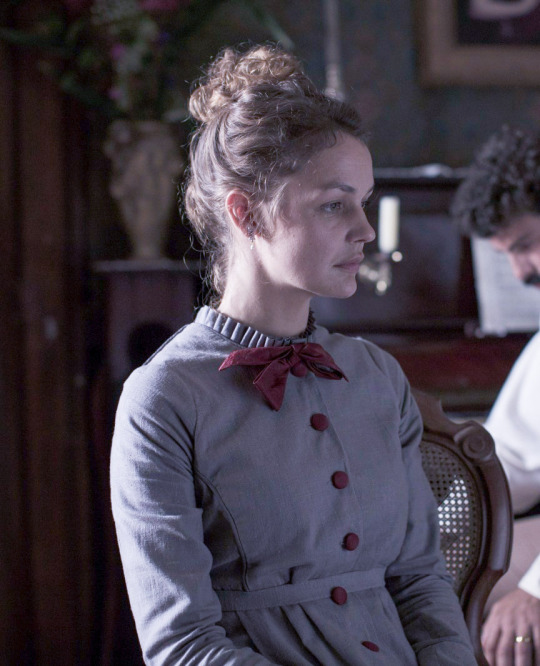

Luise Heyer as Maria Leopoldina of Austria, the Empress Consort of Brazil, Queen Consort of Portugal and Archduchess of Austria
Dona Maria Leopoldina of Austria (22 January 1797 – 11 December 1826) was born Caroline Josepha Leopoldine Franziska Ferdinanda of Habsburg-Lorraine in Vienna, Austria, Holy Roman Empire. She was the daughter of Holy Roman Emperor Franz II and Empress Maria Theresa of Naples and Sicily. In 1817 the Archduchess married Prince Dom Pedro of Braganza (12 October 1798 – 24 September 1834), heir to Portugal, later the Emperor Dom Pedro I of Brazil and King Dom Pedro IV of Portugal. The couple had 7 children: Queen Maria II of Portugal, Miguel, Prince of Beira, João Carlos, Prince of Beira, Princess Januária of Brazil, Princess Paula of Brazil, Princess Francisca of Brazil and Emperor Dom Pedro II of Brazil. On September 2, 1822 while she was the Acting Princess Regent of the Kingdom of Brazil in the absence of her husband Maria Leopoldina signed the Decree of Independence, declaring Brazil separate from Portugal. She died at age 29 in 1826 after a miscarriage. As Acting Regent Maria Leopoldina was the first woman to govern an independent Brazil, the first empress consort of the country, the first empress of the Americas and the first woman to govern an independent American country.
Victoria Guerra as Amélia of Leuchtenberg, the Empress Consort of Brazil and Duchess of Braganza
Dona Amélia of Leuchtenberg (31 July 1812 – 26 January 1873) was born Amélie Auguste Eugénie Napoléonne de Leuchtenberg in Milan, Kingdom of Italy. She was the daughter of Eugène de Beauharnais, Duke of Leuchtenberg and Princess Augusta of Bavaria, Duchess of Leuchtenberg. She was the second wife of Emperor Dom Pedro I of Brazil after their marriage in 1829 and they had one child, the Princess Maria Amélia of Brazil. After Dom Pedro I abdicated the Brazilian crown, Amélia accompanied her husband back to Europe. They held the titles of Duke and Duchess of Braganza until Pedro’s dead in 1834. Amélia died in Lisbon at the age of 60 in 1873.
A VIAGEM DE PEDRO | PEDRO, BETWEEN THE DEVIL AND THE DEEP BLUE SEA (2021). Dir. Laís Bodanzky
#a viagem de pedro#perioddramaedit#filmedit#movieedit#weloveperioddrama#worldcinemaedit#perioddramasource#onlyperioddramas#historicwomendaily#periodedits#braziliansource#cinematv#cinemapix#fyeahmovies#motionpicturesource#filmtv#filmtvdaily#userperioddrama#femaledaily#femalecharacters#flawlessbeautyqueens#historyedit#women in history#period drama#pedro between the devil and the deep blue sea#brazilian cinema#brazilian movies#mine#mine: edit#brazilian stuff
73 notes
·
View notes
Text
Partial List of Royal Saints
Saint Abgar (died c. AD 50) - King of Edessa, first known Christian monarch
Saint Adelaide of Italy (931 - 999) - Holy Roman Empress as wife of Otto the Great
Saint Ælfgifu of Shaftesbury (died 944) - Queen of the English as wife of King Edmund I
Saint Æthelberht of Kent (c. 550 - 616) - King of Kent
Saint Æthelberht of East Anglia (died 794) - King of East Anglia
Saint Agnes of Bohemia (1211 - 1282) - Bohemian Princess, descendant of Saint Ludmila and Saint Wenceslaus, first cousin of Saint Elizabeth of Hungary
Saint Bertha of Kent (c. 565 - c. 601) - Frankish Princess and Queen of Kent as wife of Saint Æthelberht
Saint Canute (c. 1042 - 1086) - King of Denmark
Saint Canute Lavard (1096 - 1131) - Danish Prince
Saint Casimir Jagiellon (1458 - 1484) - Polish Prince
Saint Cormac (died 908) - King of Munster
Saint Clotilde (c. 474 - 545) - Queen of the Franks as wife of Clovis I
Saint Cunigunde of Luxembourg (c. 975 - 1033) - Holy Roman Empress as wife of Saint Henry II
Saint Edmund the Martyr (died 869) - King of East Anglia
Saint Edward the Confessor (c. 1003 - 1066) - King of England
Saint Edward the Martyr (c. 962 - 978) - King of the English
Saint Elesbaan (Kaleb of Axum) (6th century) - King of Axum
Saint Elizabeth of Hungary (1207 - 1231) - Princess of Hungary and Landgravine of Thuringia
Saint Elizabeth of Portugal (1271 - 1336) - Princess of Aragon and Queen Consort of Portugal
Saint Emeric (c. 1007 - 1031) - Prince of Hungary and son of Saint Stephen of Hungary
Saint Eric IX (died 1160) - King of Sweden
Saint Ferdinand (c. 1199 - 1252) - King of Castile and Toledo
Blessed Gisela of Hungary (c. 985 - 1065) - Queen Consort of Hungary as wife of Saint Stephen of Hungary
Saint Helena (c. 246 - c. 330) - Roman Empress and mother of Constantine the Great
Saint Henry II (973 - 1024) - Holy Roman Emperor
Saint Isabelle of France (1224 - 1270) - Princess of France and younger sister of Saint Louis IX
Saint Jadwiga (Hedwig) (c. 1373 - 1399) - Queen of Poland
Saint Joan of Valois (1464 - 1505) - French Princess and briefly Queen Consort as wife of Louis XII
Blessed Joanna of Portugal (1452 - 1490) - Portuguese princess who served as temporary regent for her father King Alfonso V
Blessed Karl of Austria (1887 - 1922) - Emperor of Austria, King of Hungary, King of Croatia, and King of Bohemia
Saint Kinga of Poland (1224 - 1292) - Hungarian Princess, wife of Bolesław V of Poland and niece of Saint Elizabeth of Hungary
Saint Ladislaus (c. 1040 - 1095) - King of Hungary and King of Croatia
Saint Louis IX (1214 - 1270) - King of France
Saint Ludmila (c. 860 - 921) - Czech Princess and grandmother of Saint Wenceslaus, Duke of Bohemia
Blessed Mafalda of Portugal (c. 1195 - 1256) - Portuguese Princess and Queen Consort of Castile, sister of Blessed Theresa of Portugal
Saint Margaret of Hungary (1242 - 1270) - Hungarian Princess, younger sister of Saint Kinga of Poland and niece of Saint Elizabeth of Hungary
Saint Margaret of Scotland (c. 1045 - 1093) - English Princess and Queen Consort of Scotland
Blessed Maria Cristina of Savoy (1812 - 1836) - Sardinian Princess and Queen Consort of the Two Sicilies
Saint Matilda of Ringelheim (c. 892 - 968) - Saxon noblewoman and Queen of East Francia as wife of Henry I
Saint Olaf (c. 995 - 1030) - King of Norway
Saint Olga of Kiev (c. 900 - 969) - Grand Princess of Kiev and regent for her son Sviatoslav I, grandmother of Saint Vladimir the Great
Saint Oswald (c. 604 - 642) - King of Northumbria
Saint Radegund (c. 520 - 587) - Thuringian Princess and Frankish Queen
Saint Sigismund of Burgundy (died 524) - King of the Burgundians
Saint Stephen of Hungary (c. 975 - 1038) - King of Hungary
Blessed Theresa of Portugal (1176 - 1250) - Portuguese Princess and Queen of León as wife of King Alfonso IX, sister of Blessed Mafalda
Saint Vladimir the Great (c. 958 - 1015) - Grand Prince of Kiev and grandson of Saint Olga of Kiev
26 notes
·
View notes
Note
Chegando com pedido inusitado, mas acho que vcs conseguem me ajudar. Quero fazer um perso da nobreza, mas queria me basear em gente que já existiu, figuras históricas, mas não sei quais são legais, de verdade, podem me ajudar? Dando apenas o nome posso buscar no google, mas é que sou péssima em história e nunca sei quem é legal
O quanto eu amei essa ask não está escrito!! Pompurin, você veio ao lugar certo, porque eu sou o maior dump de história de realeza (ao menos, que eu conheço). Ser legal já tira todo mundo da lista, porque ninguém foi legal, eles podiam ter ações nobres e sociais, mas era por algum interesse mascarado... Nobreza nunca foi simpática, mas as histórias são magnificas. Vou separar alguns nomes para ti. [ meio edit, acho que vai ficar muito extenso, então depois da Rainha Elizabeth II, não coloquei descrições, apenas em alguns específicos. ]
Lady Di, nossa amada Princesa Diana da Inglaterra (1961-1997). Minha amada mais injustiçada, sou a maior apaixonada por tudo que a envolve (já assisti todos os documentários) e ela é um exemplo perfeito de monarca que foi contra as regras da Coroa Britânica.
Kate Middleton (1982). Atual princesa de Gales e esposa do Príncipe William da Inglaterra, além de se mostrar uma mãe exemplar (com semelhanças com sua sogra), também é um exemplo de monarca, porque ela é muito simpática com as pessoas.
Maria Leopoldina da Áustria (1797-1826). Esposa de Dom Pedro I de Portugal-Brasil. Muito importante em muitos momentos do Brasil Império.
Teresa Cristina de Bourbon-Duas Sicília (1822-1889). Imperatriz do Brasil e esposa de Dom Pedro II. Teve uma novela da Globo que mostrou muito dela, uma mãe amorosa e que cuidava de seu império, mas que teve momentos conturbados com o marido lixo.
Pedro II do Brasil (1825-1891). Último imperador do Brasil. Tenho muitos sentimentos controversos sobre o Pedro, todos envolvendo sua gestão e a mulher dele, mas a história dele vai muito além do que aprendemos na escola.
Cleópatra VII Filopator (69 a.C - 30 a.C). Falar da Cleópatra é muito !!!, ela foi uma das poucas mulheres que governaram o Egito (se não a única) e tem muita história, claro que existem as problemáticas, mas ela sempre foi estrategista e sedutora. Até hoje, seu sarcófago não foi localizado, o que indica que tem muito que não sabemos sobre.
Rainha Elizabeth II (1926-2022). Famosa "Betinha" para os brasileiros, tem muito sobre ela que dá raiva, mas ela teve muitos momentos bons na vida e claro, viveu bastante.
Rainha Vitória (1819-1901). Subiu ao trono com apenas 18 anos e tem a chamada Era Vitoriana.
Ana Bolena (1501-1533). Bela e decapitada por mando do marido, responsável pelo corte da relação Igreja X Inglaterra. Aconselho procurar o musical The Six, porque mostra todas as seis esposas do Henrique e como elas são interessantes.
Ricardo I (1157-1199). Ricardo Coração de Leão, tem uma história legal.
Henrique VIII (1491-1547). Um homem que não presta, teve várias esposas e muitas coisas rolaram no mandato dele. Aconselho ver The Tudors.
Catarina de Médici (1519-1589)
Maria Antonieta (1755-1793). Essa mulher... Vivia de luxúria e a frase dos brioches vem dela.
Luís XIV (1638-1715). Rei Sol.
Nefertiti (1370 a. C.-1330 a. C. - estimada). Descrita como a mais bela do mundo.
Mary Stuart (1542-1587)
Catarina II da Rússia (1729-1726). Nunca deixarei a Catarina, a Grande de fora. Outra rainha que admiro demais, apesar dos erros cometidos, ela foi muito sagaz e inteligente em dar um golpe no próprio marido e assumir o trono de Todas as Rússias, mesmo enfrentando grandes problemas. Existem muitos conteúdos sobre ela, mas se quiser rir, aconselho ver a série The Great.
Pedro III da Rússia (1728-1762). Teve um mandato curto porque foi deposto (sofreu O golpe da Catarina), vivia embriagado... Como ele é mostrado em The Great é um pouco demais, talvez, mas tá ali.
Rei George III do Reino Unido (1738-1820). Aquele rei lá de Queen Charlotte, ele tinha uma doença chamada porfiria, mas na época... Bem, só o chamaram de louco mesmo (aquela época era terrível).
Sophie Charlotte de Mecklemburgo-Strelitz (1744-1818). Assim como muitas figuras históricas, ela foi embranquecida, mas Charlotte era filha de portugueses e africanos, mas nasceu na Alemanha e talvez esse seja o motivo... Mas ela foi uma ótima rainha.
São alguns nomes, aqueles que lembrei para pesquisar, mas se pesquisar sobre os monarcas da Europa, com toda a certeza, vai encontrar uma infinidade! Podia falar outros, mas a Joy disse que ia ficar muita informação e ela está certa, acho que se pesquisar por esses já vai encontrar novos nomes que podem ajudar.

8 notes
·
View notes